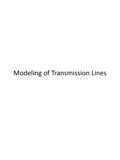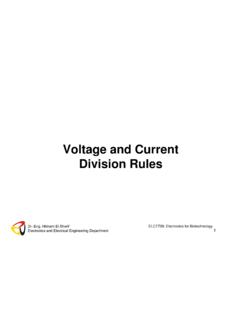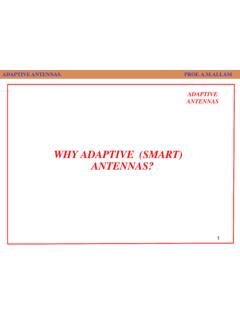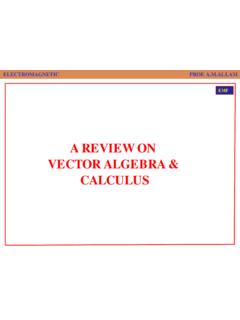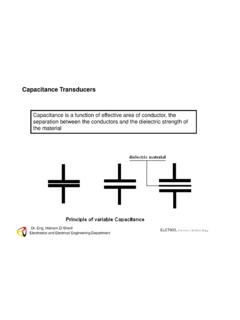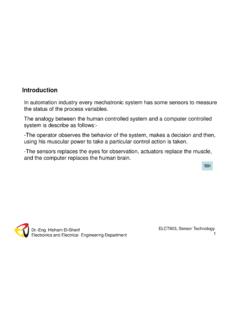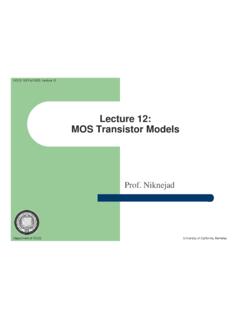Transcription of Writing Simple Spice Netlists - German University in Cairo
1 Writing Simple Spice NetlistsIntroductionSpice is used extensively in education and research to simulate analog circuits. Thispowerful tool can help you avoid assembling circuits which have very little hope of operating inpractice through prior computer simulation. The circuits are described using a Simple circuitdescription language which is composed of components with terminals attached to particularnodes. These groups of components attached to nodes are called of a Spice NetlistA Spice netlist is usually organized into different parts. The very first line is ignored bythe Spice simulator and becomes the title of the The rest of the lines can besomewhat scattered assuming the correct conventions are used. For commands, each line muststart with a . (period). For components, each line must start with a letter which represents thecomponent type (eg., M for MOSFET).
2 When a command or component description iscontinued on multiple lines, a + (plus) begins each following line so that Spice knows it belongsto whatever is on the previous line. Any line to be ignored is either left blank, or starts with a * (asterik).A Simple Spice netlist is shown below: Spice Simulation 1-1** model Descriptions **. model nm NMOS level=2 VT0= LAMBDA= ** NETLIST Description **M1 vdd ng 0 0 nm W=3u L=3uR1 in ng 50 Vdd vdd 0 5 Vin in 0 ** SIMULATION Commands **. first line is the title of the simulation. It s unimportant for the simulation except foridentification. The Spice commands under model Descriptions are used to define theelectrical properties of particular devices. In this example, the MOSFET is defined by the givenparameters in the model . In the NETLIST Description , the components are listed with thenodes they are connected to. Notice that each one starts with a letter.
3 The MOSFET starts withan M , the resistor starts with an R , and the voltage sources start with V Joshua CantrellPage common error when simulating is to place a component definition or operation on this firstline and the Spice simulator will appear to not function properly. It will either complain aboutmissing components, models, or not do what you think.+-+-VddVinR1M150 /3 Figure 1:Schematic of Spice Simulation 1-1 Netlist0ngvddinSimple Netlist ComponentsResistor ComponentThe register is described byRXXXXXXX N1 N2 <VALUE> <MNAME> <L=LENGTH> <W=WIDTH> <TEMP=T>The parameters are:N1 = the first terminalN2 = the second terminal<VALUE> = resistance in ohms.<MNAME> = name of the model used (useful for semiconductor resistors)<L=LENGTH> = length of the resistor (useful for semiconductor resistors)<W=WIDTH> = width of the resistor (useful for semiconductor resistors)<TEMP=T> = temperature of the resistor in Kelvin (useful in noise analysis andsemiconductor resistors)Notice that the parameters given with = in their definitions must be written with thesymbol followed by = followed by the value.
4 For example, to set a resistor to 500 Kelvin, you dwrite:RHOT n1 n2 10k TEMP=500 All of the parameters surrounded by < and > can be left out and will be replaced by defaultvalues. All of them must appear in order, except for the parameters with = in their ComponentThe capacitor is described byCXXXXXXX N+ N- VALUE <IC=INCOND>The parameters are:N+ = the positive terminalN- = the negative terminalVALUE = capacitance in farads<IC=INCOND> = starting voltage in a simulationInductor ComponentThe inductor is described byLYYYYYYY N+ N- VALUE <IC=INCOND>The parameters are:N+ = the positive terminalN- = the negative terminalVALUE = capacitance in farads<IC=INCOND> = starting voltage in a simulationBy Joshua CantrellPage Inductors ComponentTwo coupled inductors are described byKXXXXXXX LYYYYYYY LZZZZZZZ VALUEThe parameters are:LYYYYYYY = the name of the first coupled inductorLZZZZZZZ = the name of the second coupled inductorVALUE = the coefficient of coupling, K, where 0<K 1 The orientation of the inductors is determined by the first node, which is considered to be thedoted Diode ComponentA diode is described byDXXXXXXX N+ N- MNAME <AREA> <OFF> <IC=VD> <TEMP=T>The parameters are:N+ = the name of the positive terminalN- = the name of the negative terminalMNAME = name of the model used<AREA> = the scaling factor of the diode (determines how much current can flow through it)<OFF> = an optional starting condition for DC analysis<IC=VD> = starting voltage in a simulation<TEMP=T> = temperature of the diode in KelvinBipolar Junction Transistor (BJT) ComponentA bipolar junction transistor is described byQXXXXXXX NC NB NE <NS> MNAME <AREA> <OFF> <IC=VBE, VCE> <TEMP=T>The parameters are.
5 NC I= the name of the collector terminalNB = the name of the base terminalNE = the name of the emitter terminal<NS> = the name of the substrate terminal (optional)MNAME = name of the model used<AREA> = the scaling factor of the BJT (determines how much current can flow through it)<OFF> = an optional starting condition for DC analysis<IC=VBE, VCE> = starting voltage in a simulation<TEMP=T> = temperature of the transistor in KelvinBy Joshua CantrellPage ComponentA MOSFET transistor is described byMXXXXXXX ND NG NS NB MNAME <L=VAL> <W=VAL> <AD=VAL> <AS=VAL>+ <PD=VAL> <PS=VAL> <NRD=VAL> <NRS=VAL> <OFF>+ <IC=VDS, VGS, VBS> <TEMP=T>The parameters are:ND I= the name of the drain terminalNG = the name of the gate terminalNS = the name of the source terminalNB = the name of the bulk (backgate) terminalMNAME = name of the model used<L=VAL> = length of the gate in meters<W=VAL> = width of the gate in meters<AD=VAL> = area of the drain contact in sqare meters<AS=VAL> = area of the source contact in sqare meters<PD=VAL> = perimeter of the drain contact in meters<PS=VAL> = perimeter of the source contact in meters<NRD=VAL> = equivalent squares that make up the drain to determine the drain resistance <NRS=VAL> = equivalent squares that make up the source to determine the source resistance<OFF> = an optional starting condition for DC analysis<IC=VDS, VGS, VBS> = starting voltage in a simulation<TEMP=T> = temperature of the transistor in KelvinVoltage Source ComponentA voltage source is described byVXXXXXXX N+ N- <<DC> DC/TRAN VALUE> <AC <ACMAG <ACPHASE>>>+ <DISTOF1 <F1 MAG <F1 PHASE>>> <DISTOF2 <F2 MAG <F2 PHASE>>>The parameters are.
6 N+ I= the name of the positive terminalN- = the name of the negative terminal<<DC> DC/TRAN VALUE> = the DC offset of the voltage source<<AC> ACMAG <ACPHASE>>> = the AC magnitude and phase applied in an AC analysis<DISTOF1 <F1 MAG <F1 PHASE>>> = a distortion factor at frequency F1<DISTOF2 <F2 MAG <F2 PHASE>>> = a distortion factor at frequency F2 The DC value can be changed in time by using functions such as pulse(), sin(), exp(), and pwl().The distortion factors only operate with a .disto Joshua CantrellPage Source ComponentA current source is described byIXXXXXXX N+ N- <<DC> DC/TRAN VALUE> <AC <ACMAG <ACPHASE>>>+ <DISTOF1 <F1 MAG <F1 PHASE>>> <DISTOF2 <F2 MAG <F2 PHASE>>>The parameters are:N+ I= the name of the positive terminalN- = the name of the negative terminal<<DC> DC/TRAN VALUE> = the DC offset of the current source<<AC> ACMAG <ACPHASE>>> = the AC magnitude and phase applied in an AC analysis<DISTOF1 <F1 MAG <F1 PHASE>>> = a distortion factor at frequency F1<DISTOF2 <F2 MAG <F2 PHASE>>> = a distortion factor at frequency F2 The DC value can be changed in time by using functions such as pulse(), sin(), exp(), and pwl().
7 The distortion factors only operate with a .disto and Voltage Source DC FunctionsPulse FunctionThe pulse function is described byPULSE(V1 V2 <TD> <TR> <TF> <PW> <PER>)The parameters are:V1 = the initial value (volts or amps)V2 = the pulsed value (volts or amps)<TD> = the seconds before the first pulsed value<TR> = the seconds it takes the pulse to rise from V1 to V2<TF> = the seconds it takes the pulse to fall from V2 to V1<PW> = the number of seconds the signal stays at V2<PER> = the time between each rising edge of the pulse after the first initial pulseSinusoidal FunctionThe sinusoidal function is described bySIN(V0 VA FREQ <TD> <THETA>)The parameters are:V0 = the offset value (volts or amps)VA = the peak amplitude value (volts or amps), the peak-to-peak value is twice thisFREQ = the frequency in Hz of the sinusoid<TD> = the seconds before the start of the sinusoid<THETA > = the damping factor of the sinusoid in 1/secondBy Joshua CantrellPage FunctionThe exponential function is described byEXP(V1 V2 <TD1> <TAU1> <TD> <TAU2>)The parameters are:V1 = the initial value (volts or amps)V2 = the pulsed value (volts or amps)<TD1> = the seconds before the pulsed value<TAU1> = the rise time constant for the pulse to rise from V1 to V2<TD> = the seconds before the falling of the pulsed value<TAU2> = the fall time constant for the pulse to fall from V2 to V1 Piece-Wise Linear FunctionThe piece-wise linear function is described byPWL(T1 V1 <T2 V2 <T3 V3 <T4 V4.)
8 >>>)The parameters are:Tn = the time where the nth voltage is at the desired voltageVn = the nth voltageModel Definition CommandsGeneric model CommandThe generic model command is described MNAME TYPE(PNAME1=PVAL1 PNAME2=PVAL2 .. )The parameters are:MNAME = the name to give the modelTYPE = the type of model (eg., D, NPN, PNP, NMOS, PMOS)PNAMEn = the name of the parameter to be setPVALn = the parameter s valueDiode model (D)The diode model command is described MNAME D(PNAME1=PVAL1 PNAME2=PVAL2 .. ) coefficientN*100 ohmic resistanceRS* currentISareaexampledefaultunitsparamete rnameBy Joshua CantrellPage Cparameter measurement at breakdown breakdown for forward-bias depletioncapacitance potentialVJ*2pF0 Fzero-bias junction model (NPN/PNP)The NPN model command is described MNAME NPN(PNAME1=PVAL1 PNAME2=PVAL2 .. )The PNP model command is described MNAME PNP(PNAME1=PVAL1 PNAME2=PVAL2.
9 200infiniteVreverse Early voltageVAR11-reverse current emission maximum reverse betaBR200infiniteVforward Early current emission coefficientNF100100-ideal maximum forward betaBF* saturation currentISareaexampledefaultunitsparamete rnameBy Joshua CantrellPage CParameter measurement for forward-bias depletioncapacitance gap for temperature effect on junction exponential junction built-in potentialVJS*2pF0 Fzero-bias collector-substrate capacitanceCJS10ns0secideal reverse transit timeTR1-fraction of B-C depletion capacitance connectedto internal base junction exponential built-in potentialVJC*2pF0FB-C zero-bias depletion forward transit junction exponential built-in potentialVJE*2pF0FB-E zero-bias depletion capacitanceCJE*100 collector resistanceRC*10 emitter resistanceRE*1000 zero bias base resistanceRBareaexampledefaultunitsparam eternameMOSFET model (NMOS/PMOS)The NMOS model command is described MNAME NMOS(PNAME1=PVAL1 PNAME2=PVAL2.)
10 The PMOS model command is described MNAME PMOS(PNAME1=PVAL1 PNAME2=PVAL2 .. )By Joshua CantrellPage junction saturation current per junction (level1) (level2, 3)-bulk junction sidewall grading bulk junction sidewall cap. per meterof junction junction bottom grading bulk junction bottom cap of junction overlap capacitance per meterchannel overlap capacitance per meterchannel overlap capacitance per meterchannel junction saturation current (IS) source ohmic drain ohmic modulation (MOS1 and MOS2only) ( ) potential ( ) threshold parameter ( ) threshold voltage (VTO)VTO1- model indexLEVEL exampledefaultunitsparameternameBy Joshua CantrellPage Cparameter measurement for forward-bias depletioncapacitance drift velocity of carriers VMAX700600cm2/Vssurface diffusionLDexampledefaultunitsparametern ameBasic Simulation CommandsSet Initial Conditions (.)
